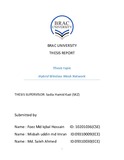Hybrid wireless mesh network
Abstract
In the last few years, there has been an immense influence of wireless networks in our daily life.
Especially, wireless mesh network has got a prominent attention in academic research and commercial deployment as well.
We are proposing Hybrid Wireless Mesh Protocol (HWMP) to enhance the performance of wireless mesh networks as statistic shows that for WMNs, the proposed routing protocol outperforms other well-known protocols in terms of different parameters like packet delivery fraction, network throughput and end-to-end delay.
HWMP defined in IEEE 802.11s, is a basic routing protocol for a wireless mesh network. It is based on AODV and tree-based routing. In HWMP, on-demand routing protocol is used for mesh nodes that experience a changing environment while in a fixed network topology proactive tree-based routing protocol is an efficient choice for mesh nodes .
Moreover, wireless mesh networks provides facilities such as ease of installation, cost effective deployments, a high level of performance in coverage area and capacity, network flexibility and self-configuration capabilities. These benefits enable seamless communication in underdeveloped areas such as rural communities. Congestion control and optimal route selection in the network layer is gained through routing protocol optimizations.
Here, Network simulator 3(ns-3) has been used to simulate our particular protocol in the simulation model. Simulation (ns3) results show that the proposed hybrid wireless mesh protocol (HMWP) significantly improves the performance of wireless mesh networks than other protocols.

